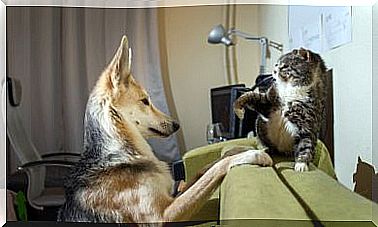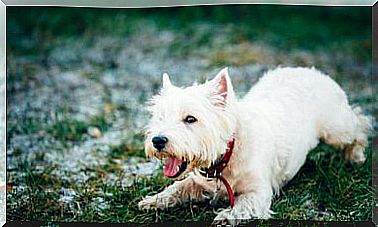Atopia: Why Is It Happening?

Atopy is a very common pathology in cats and dogs and is characterized by the appearance of skin lesions in specific regions. It is a disease with a fairly common incidence, as one dog in ten suffers from it. In addition, it has been estimated that its incidence may be increasing.
Likewise, it occurs very frequently in the population and is part of the day-to-day life of animals and people. Here are some things to keep in mind about this disease.
What is atopy?
Atopy, also known as atopic dermatitis, is a pathology with a high genetic predisposition. It is described in the literature as a chronic disease, which has no cure.
According to studies, the incidence of this pathology increases over time. This can be influenced by the aggravation and binding of allergens to different pollutants.
Its pathogenesis is varied and complex, with its own characteristics in each case. However, it has two central pathogenic mechanisms:
- Hypersensitivity to allergens in the environment.
- Alteration of the skin barrier. A dysfunction of this primary barrier against allergens is predicted.
Atopic animals or people react to contact. These allergens interact through the mucosa or skin, which produces an atypical response in the animal’s immune system.

Symptoms of atopy
Broadly speaking, atopy can be defined as an allergy to different types of environmental allergens. Mites are the most common, followed by pollen and, to a lesser extent, by other allergens. Some of the most common symptoms seen in atopy are the following:
- Skin lesions
- Itching, or what is the same, intense localized or general itching.
- Flaking
How do I observe these symptoms?
Animals manifest the itch by biting or scratching with their paws in the region of the itch. Another option to combat discomfort is rubbing against objects. All this supposes varied manifestations that go from reddish coloration, going through flaking or hairless regions.
We can also observe the location of the lesions. These follow a specific distribution: lips, abdomen, eyes, flexion regions or distal part of the extremities.
What criteria do you follow for your diagnosis?
When diagnosing this disease, the specialist will carry out a series of tests and tests to confirm your suspicion. Next, we show you the most relevant factors that condition this disease.
Clinic history
It is a disease with a high hereditary predisposition. Therefore, it is necessary to confirm if the parents or other close relatives suffer from it. It can also be seen if he had previously come for skin problems and know what the steps had been followed and if they were correct.A higher prevalence of the disease has also been described in some specific breeds of dogs:
- French bulldog
- Dalmatian.
- German shepherd.
- Poodle.
- Boxer.
- Labrador retriever.
- Shar Pei.
- Terrier .
Clinical picture
Atopy shares numerous symptoms with other different pathologies and can even be mistaken for a food allergy. Therefore, the vet will be able to perform the allergen test. This consists of inoculating the animal with the most common allergens and observing which one causes a reaction.
From that moment on, a desensitization process will begin. This consists of the elimination of the allegens responsible for the disease from the environment. Some, like mites, are usually found in everyday objects found in homes, for example, on carpets, bedspreads or others.
What treatment is recommended for atopy?
First of all, it is essential to go to the vet to certify if the pet is really atopic. If so, you will know which treatment is appropriate for your individual circumstances.
However, some measures to take into account will be discussed below:
- Control over endo and ectoparasites. The presence of parasites in atopic animals aggravates the general picture.
- Bathe the animal frequently, using a suitable shampoo. Bathing is advised to be around one to three times a week.
- It can be recommended to follow a specific diet. Therefore, the market offers a wide variety of feed.
- If the animal scratches uncontrollably, use an Elizabethan collar to prevent further damage.

Apart from these tips, the vet may choose to administer corticosteroids. Unfortunately, drugs can only control symptoms. In this way, the treatments and care must be carried out throughout the life of the pet. The frequency will be dictated by the animal itself and the veterinarian.
In summary, atopy is a pathology that is diagnosed in young cats and dogs and is detected between the first and third year of life. This disease can be controlled following the advice of the veterinarian. If you have any questions that may arise, it is better to consult a specialist.







